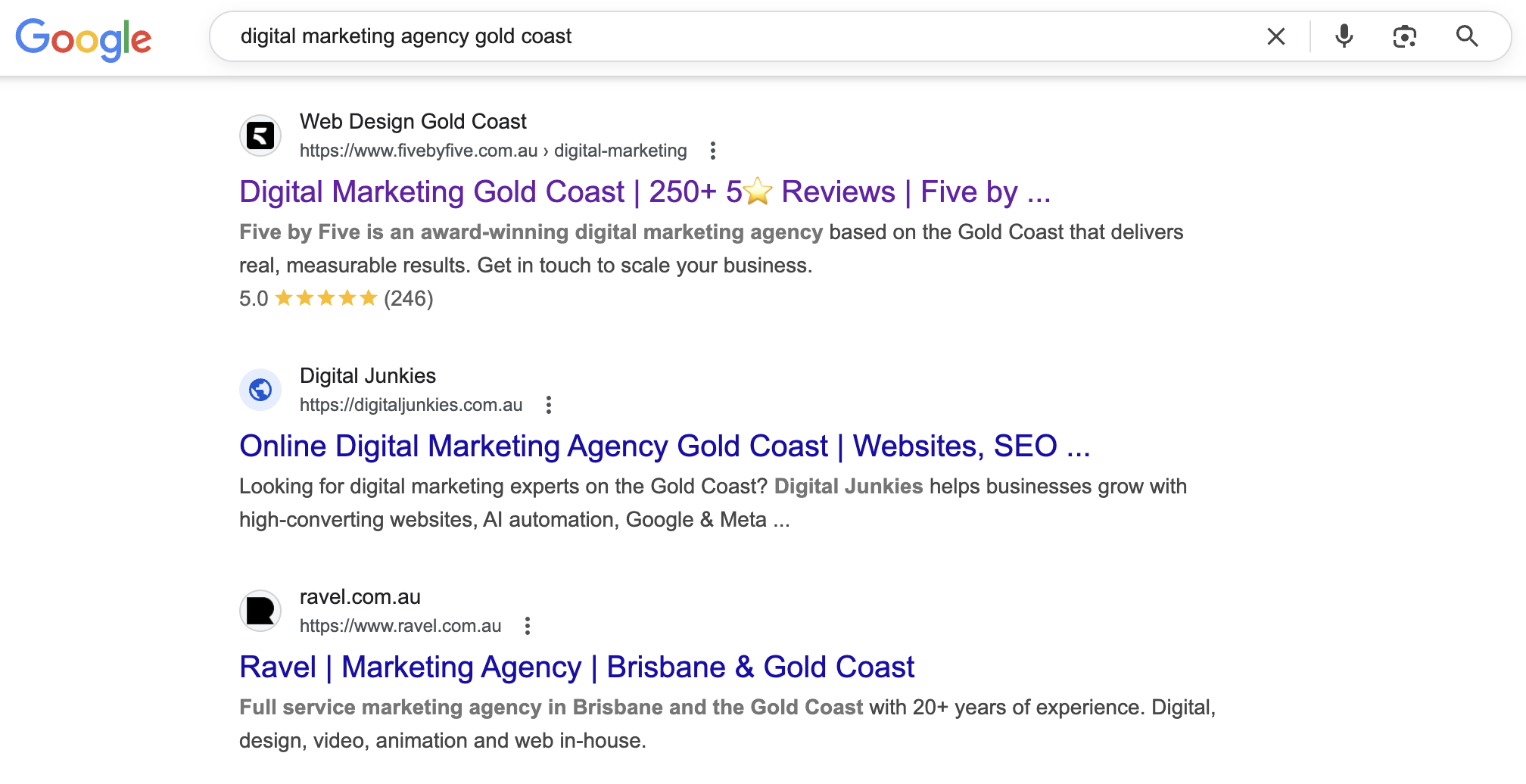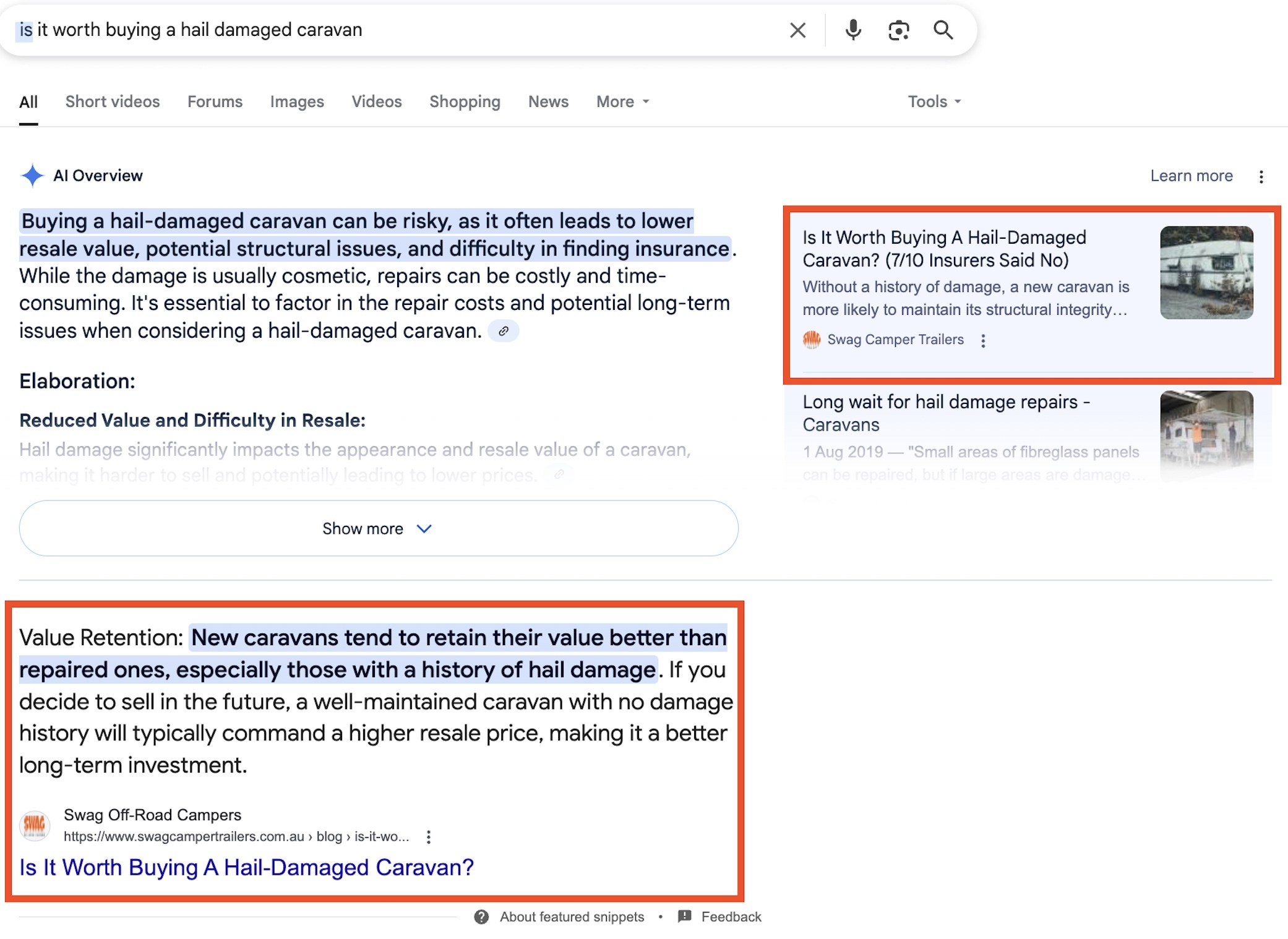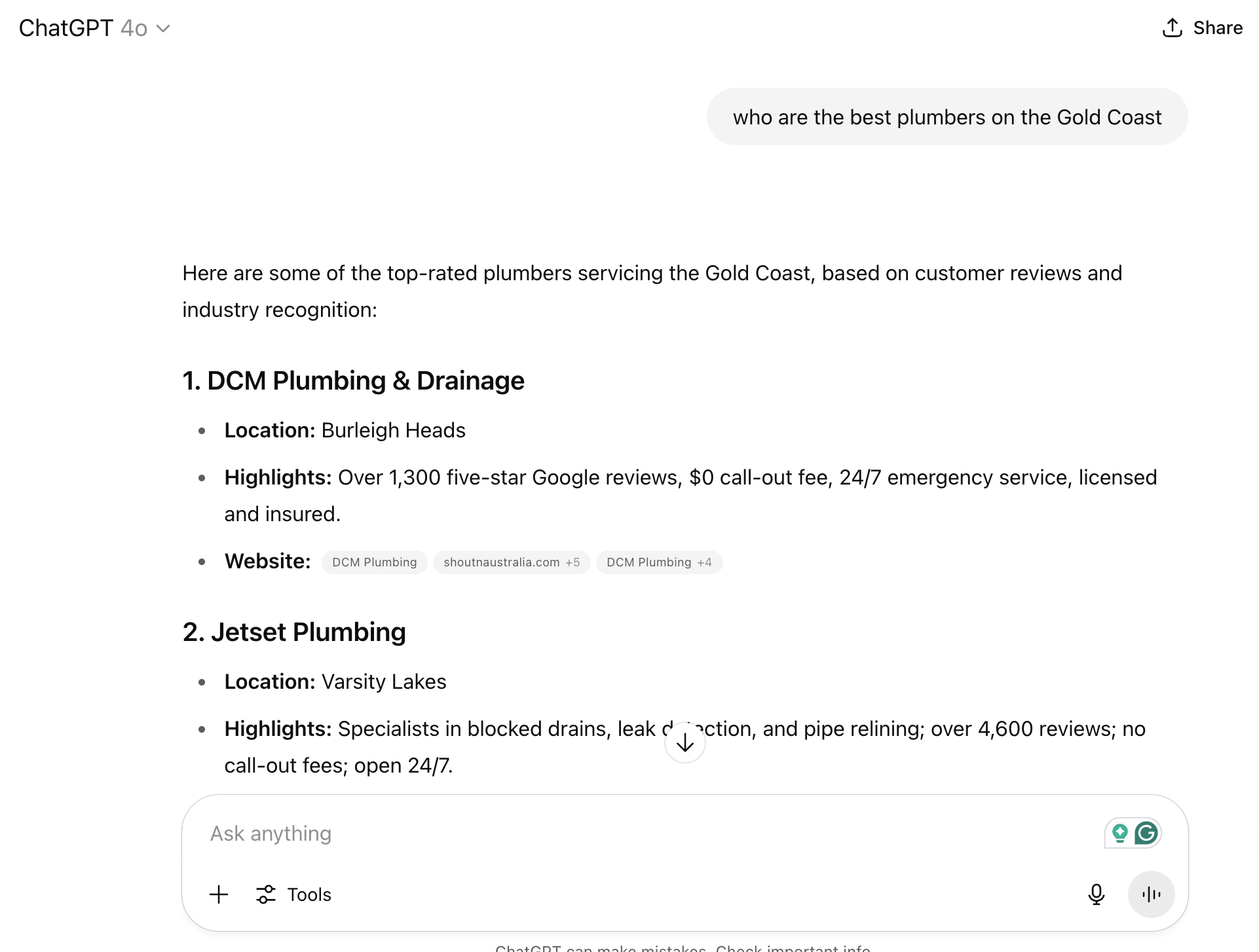There’s no shortage of new acronyms in digital marketing, and right now, AEO, GEO, and SEO are all getting thrown around like you’re supposed to just “get it.”
But here’s the truth: while they each have their quirks, they’re not competing strategies.
They’re connected.
And if your business is already focused on strong SEO fundamentals, you’re likely building the foundation needed to succeed across all three.
Today, we’re breaking down what AEO (Answer Engine Optimisation), GEO (Generative Engine Optimisation), and SEO (Search Engine Optimisation) really mean and how they each play a role in getting your business seen, clicked, and trusted.
Because once you understand how they work together, the path forward becomes a lot clearer.
At Five by Five, we’re all about helping you share your magic through great looking, high performing websites. Whether you’re a new business in need of a wow-worthy digital launch, or an established business looking to refresh and replace your old site, we have the know-how and dedication to make it happen. Contact us today to get started.
AEO, GEO, & SEO Explained in Simple Terms
| Strategy | What It Does | Where It Shows Up |
|---|---|---|
| SEO | Helps your website rank in traditional search results when people are looking for information, products, or services | The standard list of “blue links” on Google |
| AEO | Helps your content appear as a direct answer to common questions | Featured snippets, People Also Ask boxes, voice assistants, and AI Overviews |
| GEO | Increases the chances your content is used in AI-generated answers | ChatGPT, Google Gemini, Microsoft Copilot, Perplexity, and similar AI tools |
Let’s start by cutting through the noise. Here’s what each term means:
SEO (Search Engine Optimisation)
Search Engine Optimisation, or SEO, is the process of improving your website so it appears higher in Google’s search results when people are looking for information, products, or services related to your business.
Until recently, this experience had been relatively straightforward.
You’d type in a search like “plumber near me” and see a list of about 10 traditional results, commonly referred to as “blue links”, to choose from.
The goal was to rank as high as possible on that list, and SEO helped make that happen.
It’s been a core part of digital marketing for decades, and it remains one of the most reliable ways to drive organic traffic to your site.
The higher your page ranks, the more likely someone is to click through to your content instead of a competitor’s.
SEO involves a mix of elements, including:
- Optimising your content with relevant keywords
- Structuring your pages clearly so search engines can read them
- Improving site performance and user experience
- Building backlinks from trusted sources
- Keeping content accurate and up to date
When SEO is done well, it helps Google understand what your website is about and who it’s for.
In return, your pages become more visible to the right people at the right time.
It’s the foundation of any strong online strategy.
And as search continues to evolve, having those fundamentals in place gives you the best chance of staying visible, even as new formats and features are introduced.

AEO (Answer Engine Optimisation)
While the term AEO is fairly new, features such as featured snippets, People Also Ask (PAA) boxes, and voice assistants have actually been part of the Google search experience for the last few years.
More recently, the development of Google’s new AI Overviews has pushed answer-style content even further to the top of the page, often appearing above the traditional “blue links.”
These features reflect a broader shift in how Google delivers information.
Instead of listing relevant pages for users to explore, the search engine now attempts to provide direct answers by summarising content from multiple sources and displaying it instantly.
In many cases, users no longer need to click through to a website to get the information they’re looking for.
This shift has had a significant impact on organic traffic.
While AI Overviews aren’t currently appearing on more localised searches, such as “digital marketing agency gold coast”, they’re becoming increasingly common for broader, informational searches.
These are the types of searches that often sit at the top of the funnel and help build awareness and trust with potential customers.
For businesses that rely on this kind of traffic to attract leads and educate their audience, the change is noticeable.
Searches like:
- “how does X work?”
- “what is the best way to…”
are seeing fewer clicks, simply because users are finding what they need directly within the search results.
This reduces opportunities for traffic, engagement, and lead generation, as you lose the chance to connect with users on your own site.
That kind of interaction was far more common before AI Overviews were introduced.
In short, AEO reflects the growing trend of search engines acting more like answer engines. It’s changing how users interact with content in search results.

GEO (Generative Engine Optimisation)
GEO stands for Generative Engine Optimisation.
It refers to the process of making your content more likely to be picked up and referenced by generative AI tools like ChatGPT, Google Gemini, Microsoft Copilot, and Perplexity, to name a few.
Unlike traditional search engines that list links or even answer engines that display direct summaries, generative engines create responses from scratch.
They draw on a wide range of sources across the web and use large language models (LLMs) to write answers in a conversational format.
These tools don’t show a list of search results.
Instead, they generate a complete answer to the question, often without clearly showing where the information came from.
As more users turn to AI tools to ask questions and get recommendations, the role of GEO is becoming more important.
It’s a shift in how content is discovered.
Rather than ranking in a list or appearing in a snippet, your goal is to be included in the AI’s response, even if the user never visits your site directly.
This changes how visibility works.
That means you’re not just optimising for clicks anymore, you’re optimising for relevance and influence within the AI’s output.
And while the concept is new, the foundation is still familiar: helpful, clear, authoritative content gives you the best chance of being cited or referenced by generative tools.
In short, GEO reflects how content is now being used to shape AI-generated answers.
It’s less about search results and more about being part of the response itself.

What This Means for Your Digital Strategy
Should I do anything differently to optimise my website for AEO & GEO?
Right now, most of what helps you rank in search also helps you show up in AI Overviews and generative responses.
From our experience, the fundamentals haven’t changed.
It’s still about creating useful, relevant content around the topics you want your brand to be known for.
Whether your content appears in a traditional search result, an AI Overview, or a ChatGPT response, the same rules apply.
Be clear, be helpful, and be trusted.
There may come a time when optimising for generative tools looks very different from SEO.
But for now, since both still rely heavily on content to understand and deliver answers, we’ve found that sticking to a strong content strategy gives you the best chance of showing up wherever people are looking for answers.
Overlapping Tips to Help You Show Up in SEO, AEO, and GEO
While it seems like there are a million strategies out there on how to appear in Google’s AI Overviews and ChatGPT results, we’ve found that these 4 core steps give you the best shot at getting found across all 3 types of search experiences:
1. Start with pages that drive revenue. Whatever industry you’re in, prioritise building out your service, product, and collection pages as these are your key money-makers. They’re the pages that appear for Bottom of the Funnel (BOFU) keywords on search engines and prompts on LLM platforms like ChatGPT.
2. If they’re not ranking, build support content. Add helpful blog articles that cover related questions and topics to strengthen your subject matter expertise. The more relevant topics your site ranks for, the more likely search engines are to see your business as a trusted source. This can lead to higher rankings for your main service or product pages, which are often the ones that drive leads and sales.
3. Tackle Middle of the Funnel (MOFU) content next. Focus on topics your customers are actively researching while they compare services, products, or solutions. These people are already interested in what you offer and are weighing up their options, so they’re more likely to convert if your content answers their questions clearly and builds trust.
4. Then create Top of the Funnel (TOFU) content. This is where you attract people at the very start of their buying journey. Write blog posts that address common early-stage questions or problems they’re trying to solve. These topics help new users discover your brand and start building familiarity, even if they’re not ready to take action yet.
In SEO, before AEO and GEO were part of the conversation, this approach was considered the best way to build “topical authority” — where your site is recognised by search engines as a trusted source on a specific subject.
But because platforms like AI Overviews and ChatGPT also rely on content to generate answers, this same strategy now increases your chances of being included in their responses too.
That being said, there are a couple of subtle differences you should be aware of to ensure you give your business the best possible chance of appearing in all types of search results.
First, let’s explore the nuances of ranking in organic search compared to AI Overviews and how to win at both.
What Works Best for Organic Search vs AI Overviews
We’ve seen a noticeable difference in how content is treated across traditional organic search results and Google’s AI Overviews.
Here are our findings:
What works for Organic Search
- Longer-form content wins when it answers a broader range of related questions and ranks for secondary keywords.
- Original insights matter. Pages that offer something new, like 1st-party data, expert commentary, or fresh analysis, tend to rank better on search engines.
- Confident, expert viewpoints help. Google rewards content that clearly demonstrates subject matter expertise and presents a well-informed stance.
What works for AI Overviews
- Content that directly answers the question – AI Overviews are built to give users quick, clear answers. To be featured, your content needs to stay tightly focused on the question being asked, with minimal fluff. Google tends to reward content that’s well-structured, easy to interpret, and sticks to the point.
- Clear, neutral language that avoids strong bias – AI-generated answers tend to favour objective, easy-to-understand explanations over strong opinions or emotionally charged statements. If you do need to take a stance, try to present both pros and cons to give a more balanced perspective.
- Content that reflects the broader consensus – AI Overviews are trained to reflect the most common, reliable answers across the web, not just a single source. If your content strays too far from what trusted sites are saying (without credible evidence), it’s less likely to be included.
If you just read this and thought to yourself, “what works for one seems to go against what works for the other”, you’re not wrong.
Balancing both isn’t always easy, but it is possible.
The key is combining original insights and expert opinions with viewpoints that broadly align with the consensus.
Blending Consensus with Original Insight: A Case Study
One of our clients, SWAG Camper Trailers, wanted to target the keyword “is it worth buying a hail-damaged caravan?”
When researching, we noticed the AI Overview leaned towards a clear consensus: most sources agreed it’s generally not worth the risk due to issues like low resale value and insurance limitations.
Rather than just repeating what was already out there, we looked for a way to add something useful.
We reached out to 10 of Australia’s biggest caravan insurers and asked whether they would cover a hail-damaged caravan.
Seven said no.
This supported the general consensus, but added original, first-hand insight that no other blog had included.
By combining trusted, widely accepted information with new data, the blog now ranks 1st in both the AI Overview and traditional organic search results.

We’ve helped hundreds of businesses turn search visibility into real sales with smart, proven content strategies like this one.
Grab your free SEO audit to uncover where you’re missing out on leads and revenue.
What about ChatGPT? How can we optimise for LLMs?
What we’ve noticed with our clients is that there is more of a correlation between pages that rank highly in Google search results and the ones that get mentioned in LLM responses.
While LLMs like ChatGPT are trained on vast datasets scraped from across the web, when prompted for more current or specific information, they rely on Microsoft Bing’s search infrastructure to provide an accurate answer.
This means they often reference similar sources to what you’d find in Google results.
So, if your content is performing well on Google, there’s a higher chance it will also be picked up and referenced in ChatGPT responses.
One advantage of ChatGPT is that it often displays its sources, giving you clear visibility into which sites it’s referencing and how often.
This allows you to reverse-engineer any patterns in 3rd party websites or types of pages that are being favoured for a particular prompt.
What we recommend is brainstorming middle and bottom-of-the-funnel prompt themes that your audience would realistically type into ChatGPT, and checking which pages are cited most often in response.
For our client DCM Plumbing, these might include:
- “Which plumbing companies offer same-day hot water system repairs near me?”
- “I need a plumber now for a burst pipe. Who do you recommend?”
- “What’s the average cost to fix a blocked drain in Queensland?”
- “Who are the best plumbers on the Gold Coast?”
For example, in response to the prompt “Who are the best plumbers on the Gold Coast?”, ChatGPT listed DCM Plumbing as the top recommendation.

If you scroll down this thread, you’ll also notice a prompt requesting a list of all of the URLs ChatGPT sourced to determine the rankings, along with how often each was cited. Below are the findings:
As you can see, there is a trend showing for this type of question, ChatGPT is favouring well-structured directory-style listicles.
If DCM Plumbing wasn’t already listed, we’d suggest reaching out to these sites to secure inclusion or improve their ranking position.
That small step could be the difference between showing up in a high-value ChatGPT response or not at all.
And it’s worth the effort.
While ChatGPT referral traffic is still a smaller slice of the pie, the leads it brings in are often highly qualified.
We’ve had clients tell us directly that customers found them because ChatGPT recommended their business.
If you’re looking for a quick win to boost visibility and attract high-quality leads, this could be it.
Putting It All Together: SEO, AEO, and GEO Aren’t Competing – They’re Connected
If your content is well-structured, focused, and genuinely useful, you’re already doing most of what’s needed to succeed across SEO, AEO, and GEO.
The platforms might differ, but the foundations remain the same:
- Build out pages that target bottom-of-the-funnel intent.
- Strengthen those pages with helpful, relevant blog content.
- Ensure your content provides the best possible value to your audience.
If you combine those foundations with the AEO and GEO tips we’ve covered, you’ll be in a strong position to earn traffic across all three search experiences.
We recommend that you forget the acronyms.
Instead, focus on building content that helps people make decisions and take the next step, wherever they’re searching.
Want to Know if Your Site Is GEO, AEO, and SEO Ready?
We’ve helped hundreds of businesses turn search visibility into real sales with practical, proven content strategies like the ones in this article.
Get a free SEO audit, and we’ll show you exactly where you’re missing out and how to fix it.






